Hazardous
Trees
Hazardous trees pose significant risks to people, property, and the surrounding environment. Here are some dangers associated with hazardous trees:
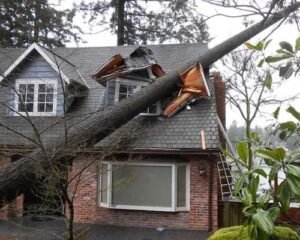 Tree Failure: Hazardous trees may have structural weaknesses, decay, or root issues that increase the likelihood of tree failure. This can result in branches falling, trees toppling over, or significant tree damage.
Tree Failure: Hazardous trees may have structural weaknesses, decay, or root issues that increase the likelihood of tree failure. This can result in branches falling, trees toppling over, or significant tree damage.Property Damage: Falling branches or trees can cause extensive damage to buildings, vehicles, fences, power lines, and other structures on the property. The financial cost of repairing such damage can be substantial.
Personal Injury: Hazardous trees pose a risk of injury to individuals, especially when branches fall unexpectedly or trees collapse. People near or beneath a hazardous tree are at risk of being struck and injured.
Public Safety Concerns: Hazardous trees in public spaces, parks, and along roads can pose a safety hazard to pedestrians, cyclists, and motorists. Falling branches or trees can lead to accidents and injuries.
Utility Disruption:
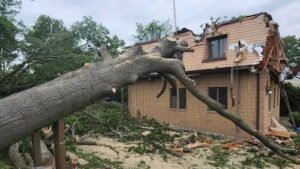 Trees near power lines or utility poles can cause power outages, disruptions to services, or electrical hazards if they come into contact with utility lines. This can lead to inconvenience and potential safety risks.
Trees near power lines or utility poles can cause power outages, disruptions to services, or electrical hazards if they come into contact with utility lines. This can lead to inconvenience and potential safety risks.Environmental Impact: Hazardous trees can impact the surrounding ecosystem by disrupting habitats, damaging vegetation, and altering natural landscapes. Tree failure can also result in the spread of pests and diseases to other trees.
Liability Issues: Property owners or municipalities may be held liable for damages or injuries caused by hazardous trees on their premises. Failure to address known hazards can result in legal consequences and financial liabilities.
Economic Loss: Businesses located near hazardous trees may experience economic losses due to property damage, closures, or decreased foot traffic resulting from safety concerns associated with the trees.
To mitigate the dangers of hazardous trees, it is essential to:
- Regularly inspect trees for signs of decay, disease, structural issues, or other hazards.
- Prune or remove hazardous trees in a timely manner to prevent potential accidents or damage.
- Consult with certified arborists or tree care professionals to assess tree health and address concerns.
- Implement proactive tree maintenance practices, such as pruning, watering, fertilization, and pest management, to promote tree health and reduce risks.
- Develop and implement a tree risk management plan to prioritize and address hazardous trees based on their level of risk and potential impact.
By identifying and addressing hazardous trees promptly, property owners, municipalities, and communities can enhance safety, protect assets, and preserve the health and well-being of both people and the environment.
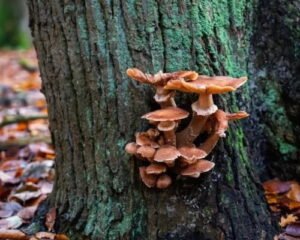 Fungal Disease
Fungal Disease
Trees can be affected by various fungal diseases, which can lead to issues such as leaf spots, wilting, cankers, and overall decline in tree health. Some common fungal diseases that affect trees include oak wilt, Dutch elm disease, anthracnose, and powdery mildew. Proper identification of the specific disease is important for implementing appropriate treatment measures, which may include pruning affected branches, applying fungicides, improving tree vigor, and practicing good sanitation. If you suspect that your trees are affected by a fungal disease, it’s recommended to consult with a certified arborist or local extension service for guidance on management strategies specific to your area and tree species.
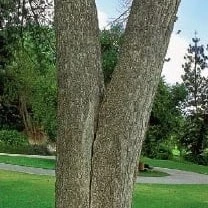 Codominant Trunks
Codominant Trunks
Codominant stems or trunks refer to a situation where a tree has two or more main stems or trunks that are similar in size and grow upward from the base of the tree. This condition can lead to structural weaknesses as the attachment between the stems is often weak, making the tree more susceptible to failure, especially during strong winds or heavy snow loads.
To address codominant stems and reduce the risk of failure, arborists may recommend strategies such as selective pruning to remove one of the competing stems, installing support cables or braces to improve the tree’s structural stability, or gradual reduction of one of the stems over time to favor a single dominant leader. Proper management of codominant stems is essential to prevent tree failure and promote the long-term health and safety of the tree. If you have concerns about codominant stems in your trees, it’s best to consult with a certified arborist for a professional assessment and recommendations.
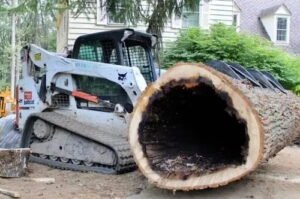 Cavity Rot
Cavity Rot
Cavity rot in trees is a common issue caused by fungal decay that results in the formation of hollow or decaying cavities within the trunk or branches of a tree. These cavities can weaken the structural integrity of the tree, increasing the risk of branch or stem failure, especially during severe weather conditions.
It’s essential to monitor trees for signs of cavity rot, such as hollowed areas, fungal growth, discolored bark, or presence of insects like wood-boring beetles. If you suspect that a tree on your property is affected by cavity rot, it’s advisable to consult with a certified arborist to assess the extent of decay and determine the best course of action.
Depending on the severity of the cavity rot and the tree’s overall health, management options may include structural support systems like cables or braces, selective pruning to remove compromised branches, targeted fungicide applications to halt the progression of decay, or in some cases, tree removal if the safety risk is too high. Regular tree inspections and timely interventions can help mitigate the hazards associated with cavity rot and promote the longevity of your trees.
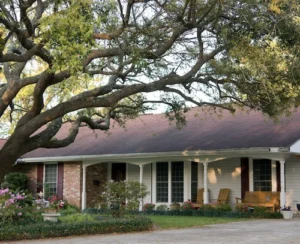 Overhanging Branches
Overhanging Branches
Overhanging branches can indeed pose a risk of damage if they break or fall, especially if they extend over roofs or power lines. These branches may become structurally weak over time due to factors like disease, pest infestations, or storm damage, increasing the likelihood of breakage. In the event of branch failure, there is a potential for property damage, injuries, and disruptions in power supply if branches fall onto roofs or power lines.
To mitigate the risk of damage from overhanging branches, it’s advisable to regularly inspect trees on your property for any signs of weakness, disease, or overextension. Pruning can help remove dead, diseased, or weak branches before they become hazardous. In cases where large branches extend over structures or power lines, it may be necessary to hire a professional arborist to safely trim or remove these branches to prevent potential damage.
Taking proactive measures to address overhanging branches can help ensure the safety of your property, prevent damage, and maintain the health and structure of your trees. If you’re unsure about the best course of action for addressing overhanging branches, consulting with a certified arborist can provide you with expert advice tailored to your specific situation.
Pests and Disease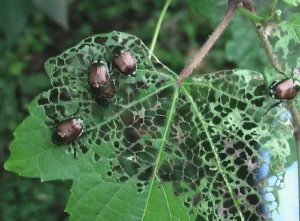
Trees can face various hazards from pests and diseases, which can compromise their health and structural integrity. Some common tree pests and diseases that pose significant threats include:
- Insects: Insects such as emerald ash borer, Asian longhorn beetle, and gypsy moth can infest and damage trees, leading to defoliation, dieback, and ultimately tree decline.
- Fungal Diseases: Fungal diseases like powdery mildew, anthracnose, oak wilt, and Dutch elm disease can cause leaf spots, wilting, cankers, and rot in trees, affecting their overall health.
- Bacterial Infections: Bacterial infections such as fire blight and bacterial leaf scorch can impact trees, causing symptoms like leaf necrosis, wilting, and dieback.
- Root Rot: Root rot caused by fungi can lead to decay of the tree’s root system, weakening its stability and nutrient uptake.
- Galls and Witches’ Broom: Abnormal growths like galls and witches’ broom can be caused by various factors, including pests and diseases, affecting the appearance and vitality of trees.
Early detection and proper management of pests and diseases are essential to protect trees from harm. Practices like maintaining tree vigor through proper watering and fertilization, promoting good air circulation, implementing integrated pest management strategies, and timely treatment with appropriate fungicides or insecticides can help mitigate the risks posed by tree pests and diseases. Consulting with a certified arborist or horticulturist can provide tailored solutions for managing pest and disease issues specific to your trees and location.
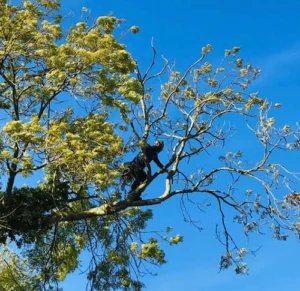 Dead or Weak Branches
Dead or Weak Branches
Dead, diseased, or weak branches can break and fall unexpectedly, creating risks to people, structures, and vehicles beneath the tree. These falling branches can cause property damage, injury, or even fatality in severe cases.
To mitigate the risk of falling branches, regular tree inspections are crucial to identify and address dead, diseased, or weak branches before they become hazardous. Proper tree maintenance, including pruning to remove deadwood and promote healthy growth, can help reduce the likelihood of branch failure.
It is also advisable to keep a safe distance from trees with potentially hazardous branches and to seek professional help from arborists or tree care specialists for assessing and managing tree risks, especially for larger or mature trees. By staying proactive and addressing potential hazards promptly, you can help ensure the safety of people and property around your trees.
Leaning Trees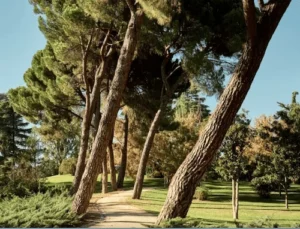
Leaning trees can present a hazard if they are at risk of falling or if their roots are compromised. Here are some reasons why leaning trees can be hazardous:
- Risk of Falling: Leaning trees are more prone to falling over, especially during strong winds, heavy rain, or snow. This can pose a danger to people, structures, and vehicles in the vicinity.
- Root Issues: Leaning trees may have compromised root systems, which can affect their stability and ability to support themselves. Root issues can result from soil compaction, construction damage, or diseases that weaken the roots.
- Structural Weakness: The angle and extent of the lean can indicate structural weaknesses within the tree, such as decay, disease, or poor branch distribution. These factors can contribute to the risk of tree failure.
If you have a leaning tree on your property that you believe poses a hazard, it is important to take action to address the situation. Seeking assistance from a certified arborist or tree care professional is recommended to evaluate the tree’s condition, determine the cause of the lean, and recommend appropriate measures to mitigate the hazard. Depending on the severity of the lean and the tree’s overall health, solutions may include cabling and bracing, corrective pruning, or in some cases, tree removal to ensure safety. Prompt attention to leaning trees can help prevent accidents and property damage.
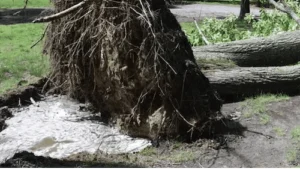 Root Rot
Root Rot
Root rot is the number one cause of trees that uproot in storms.
Root rot is indeed a significant factor that can contribute to trees uprooting during storms. Root rot is a fungal disease that affects a tree’s root system, causing decay and weakening the tree’s anchorage in the soil. When a tree’s root system is compromised by root rot, it can lose stability and may be more susceptible to uprooting, especially under the influence of strong winds, heavy rain, or saturated soil conditions during storms.
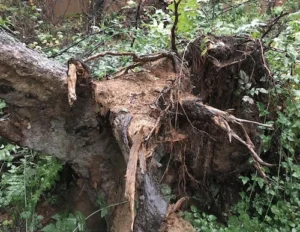 The decay of roots due to root rot reduces the tree’s ability to securely anchor itself in the ground, making it more likely to topple over when exposed to external forces. Additionally, the loss of structural support from compromised roots can result in trees becoming unstable and increasing the risk of uprooting.
The decay of roots due to root rot reduces the tree’s ability to securely anchor itself in the ground, making it more likely to topple over when exposed to external forces. Additionally, the loss of structural support from compromised roots can result in trees becoming unstable and increasing the risk of uprooting.
Proper tree care practices, including regular inspections for signs of root rot, timely treatment of affected trees, and mitigation measures to improve root health, can help reduce the risk of trees uprooting during storms. If you suspect that a tree on your property is affected by root rot, consulting with a certified arborist for a professional assessment and appropriate management recommendations is key to maintaining tree health and safety.